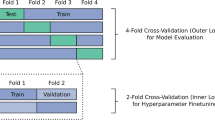Abstract
Both kinematic parameters and ground reaction forces (GRFs) are necessary for understanding the biomechanics of running. Kinematic information of a runner is typically measured by a motion capture system whereas GRF during the support phase of running is measured by force platforms. To analyze both kinematics and kinetics of a runner over several subsequent contacts, an instrumented treadmill or alternatively several force platforms installed over a regulated space are available options, but they are highly immovable, expensive, and sometimes even impractical options. Naturally, it would be highly useful to predict GRFs using a motion capture system only and this way reduce costs and complexity of the analysis. In this study, the machine learning model for vertical GRF magnitude prediction based on running motion information of 128 healthy adults is proposed. The predicted outputs of a multilayer perceptron model were compared with the actual force platform measurements. The results were evaluated with Pearson’s correlation coefficient through a tenfold cross validation. The mean standard error of the estimate was 0.107 body weights showing that our method is sufficiently accurate to identify abnormalities in running technique among recreational runners.




Similar content being viewed by others
References
van Mechelen W (1992) Running injuries. A review of the epidemiological literature. Sports Med 14(5):320–335
Keller TS, Weisberger AM, Ray JL, Hasan SS, Shiavi RG, Spengler DM (1996) Relationship between vertical ground reaction force and speed during walking, slow jogging, and running. Clin Biomech 11(5):253–259
Oh SE, Choi A, Mun JH (2013) Prediction of ground reaction forces during gait based on kinematics and a neural network model. J Biomech 46(14):2372–2380
Choi A, Lee JM, Mun JH (2013) Ground reaction forces predicted by using artificial neural network during asymmetric movements. Int J Precis Eng Manuf 14(3):475–483
Corazza S, Mündermann L, Chaudhari AM, Demattio T, Cobelli C, Andriacchi TP (2006) A markerless motion capture system to study musculoskeletal biomechanics: visual hull and simulated annealing approach. Ann Biomed Eng 34(6):1019–1029
Fernández-Baena A, Susín A, Lligadas X (2012) Biomechanical validation of upper-body and lower-body joint movements of kinect motion capture data for rehabilitation treatments. In: Fourth international conference on intelligent networking and collacorative systems, pp 656–661
Ren L, Jones RK, Howard D (2008) Whole body inverse dynamics over a complete gait cycle based only on measured kinematics. J Biomech 41(12):2750–2759
Ardestani MM, Zhang X, Wang L, Lian Q, Liu Y, He J, Li D, Jin Z (2014) Human lower extremity joint moment prediction: a wavelet neural network approach. Exp Syst Appl 41(9):4422–4433
Staudenmann D, Robadey J, Lorenzetti S, Taube W (2015) Estimation of force, stiffness and elastic energy based on kinematic data while running. In: The 25th Congress of the International Society of Biomechanics, Glasgow, UK, 2015
Bishop CM (2006) Pattern recognition and machine learning. Springer, Berlin
Minsky M, Seymour P (1969) Perceptrons. MIT Press, Oxford
Duda RO, Hart PE, Stork DG (2001) Pattern classification, 2nd edn. Wiley, New York
Hornik K, Stinchcombe M, White H (1989) Multilayer feedforward networks are universal approximators. Neural Netw 2(5):359–366
Foresee FD, Hagan MT (1997) Gauss-newton approximation to Bayesian learning. Int Joint Conf Neural Netw 3:1930–1935
Kulmala JP, Korhonen MT, Kuitunen S, Suominen H, Heinonen A, Mikkola A, Avela J (2014) Which muscles compromise human locomotor performance with age? J R Soc Interface 11(100):20140858
Zadpoor AA, Nikooyan AA (2011) The relationship between lower-extremity stress fractures and the ground reaction force: a systematic review. Clin Biomech 26(1):23–28
Milner C, Ferber R, Pollard C, Hamill J, Davis I (2006) Biomechanical factors associated with tibial stress fracture in female runners. Med Sci Sports Exerc 38(2):323–328
Liu Y, Shih SM, Tian SL, Zhong YJ, Li L (2009) Lower extremity joint torque predicted by using artificial neural network during vertical jump. J Biomech 42(7):906–911
Acknowledgements
This study was supported by the Finnish Funding Agency for Technology and Innovation (Tekes) and the Academy of Finland.
Author information
Authors and Affiliations
Corresponding author
Rights and permissions
About this article
Cite this article
Niemelä, M., Kulmala, JP., Kauppi, JP. et al. Prediction of active peak force using a multilayer perceptron. Sports Eng 20, 213–219 (2017). https://doi.org/10.1007/s12283-017-0236-z
Published:
Issue Date:
DOI: https://doi.org/10.1007/s12283-017-0236-z




